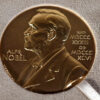How should we live when we know we must die? This question is posed by the first work of world literature, the Gilgamesh epic. More than 4,000 years ago, Gilgamesh set out on a quest for immortality. Like all Babylonian literature, the saga has survived only in fragments. Nevertheless, scholars have managed to bring two-thirds of the text into readable condition since it was rediscovered in the 19th century.
The Babylonians wrote in cuneiform characters on clay tablets, which have survived in the form of countless fragments. Over centuries, scholars transferred the characters imprinted on the pieces of clay onto paper. Then they would painstakingly compare their transcripts and—in the best case—recognize which fragments belong together and fill in the gaps. The texts were written in the languages Sumerian and Akkadian, which have complicated writing systems. This was a Sisyphean task, one that the experts in the Electronic Babylonian Literature project can scarcely imagine today.
Digitization of all surviving cuneiform tablets
Enrique Jiménez, Professor of Ancient Near Eastern Literatures at LMU’s Institute of Assyriology, and his team have been working on the digitization of all surviving cuneiform tablets since 2018. In that time, the project has processed as many as 22,000 text fragments.
“It’s a tool that didn’t exist before, a huge database of fragments. We believe it can play a vital role in reconstructing Babylonian literature, allowing us to make much faster progress.” Aptly named the Fragmentarium, it is designed to piece together fragments of text using systematic, automated methods. The designers expect that the program will also be able to identify and transcribe photos of cuneiform scripts in the future. To date, thousands of additional cuneiform fragments have been photographed in collaboration with the British Museum in London and the Iraq Museum in Baghdad.
An algorithm discovers new texts and matches up fragments
The team is training an algorithm to piece together fragments that have yet to be situated in their proper context. Already, the algorithm has newly identified hundreds of manuscripts and many textual connections. In November 2022, for example, the software recognized a fragment that belongs to the most recent tablet of the Gilgamesh epic, which dates from the year 130 BC—making it thousands of years younger than the earliest known version of the Epic. It is very interesting, remarks Jiménez, that people were still copying Gilgamesh at this late period.
In February 2023, the LMU researcher will publish the Fragmentarium. For the first time, he will also release a digital version of the Epic of Gilgamesh. The new edition will be the first to contain all known transcriptions of cuneiform fragments to date.
Since the project started, around 200 scholars worldwide have had access to the online platform for their research projects. Now it is to be made available to the public as well. “Everybody will be able to play around with the Fragmentarium. There are thousands of fragments that have not yet been identified,” says Jiménez.
When spring came to Babylon
Enrique Jiménez wants to close the gaps in Babylonian literature piece by piece. Through his work in the project over the past few years, he has not only discovered new texts and authors, but also found previously unknown genres: “For example, I’m working with an Iraqi colleague on a text that is a hymn to the city of Babylon, a very lively hymn. The text is delightful. You can picture the city very clearly. It describes how spring comes to Babylon.”
Babylon was once the largest city in the world. It straddled the river Euphrates at a site some 85 kilometers south of modern-day Baghdad. Founded in the second millennium before Christ, the ancient metropolis was the seat of King Hammurabi, who expanded the empire he inherited so that it stretched from the Persian Gulf to northern Iraq. Between the 7th and 6th centuries BC, Babylon experienced a second golden age. (In 2019, the ancient city was declared a UNESCO World Heritage Site.)
(The river of Babylon,) Araḫtu is its name,
(crafted by Nudimmud, the lord of wisdom,)
Waters the pasture, soaks the reed-thicket,
Pours its waters into sea and lagoon.
Its fields sprout with new growth,
In its meadows, aglow, barley springs up.
Thanks to its flow, mounds of grain are piled high,
The grassland grows tall, for flocks to roam and graze.
It multiplies, lavishes, and showers the land
With wealth and splendor—what befits mankind.
“Previously, there were no known hymns to cities in Babylonian literature. We have found 15 new fragments of this text. Without the Fragmentarium, the reconstruction process would have taken 30, 40 years,” says Jiménez. His team also discovered that the text played an important role in the classroom, as Babylonian schoolchildren were required to copy it out as an exercise.
Texts of timeless relevance
“There’s so much work to do in the study of Babylonian literature. The new texts we’re discovering are helping us understand the literature and culture of Babylon as a whole,” says Enrique Jiménez. The expert in ancient Near Eastern studies is inspired by the beauty of the texts and their timeless relevance: “The questions the Babylonians asked themselves are not arbitrary. They concern us to this day. People always talk about Gilgamesh and the question of mortality. The Babylonians tried to answer it. They did not succeed, because there is no answer to the question. But the very fact that they addressed it, that they tried to find an answer, is helpful nonetheless.”
At some time we build a household,
at some time we start a family,
at some time the brothers divide (the inheritance),
at some time feuds arise in the land.
At some time the river rose (and) brought the flood,
the mayfly floating on the river.
Its countenance was gazing on the face of the sun,
then all of a sudden nothing was there!
There is no canonical reading of the saga, which has influenced world literature for millennia. “It’s up to the reader how they understand the text,” says Enrique Jiménez. Gilgamesh returns to his hometown of Uruk, the first city in the history of the world according to modern scholarship. At this point, the narration breaks off abruptly and the text switches to an enumeration of the size of the city and its public squares. “Gilgamesh comes home and says, ‘Uruk is actually a beautiful city.’ There’s something deeper going on beneath this,” says Jiménez. In this interpretation, the episode shows that although people are mortal as individuals, they live on as part of the city in which they live and of the human society to which they belong.
Enrique Jiménez was there. On a shelf in his office at LMU, a photo shows a seemingly flat plain. You have to lean in and squint to recognize the faint suggestion of a line, part of the once mighty city walls. Even the great city of Uruk, Gilgamesh’s hometown, fell to ruin.
More information:
Electronic Babylonian Literature: github.com/ElectronicBabylonianLiterature
Provided by
Ludwig Maximilian University of Munich
Citation:
Researcher uses AI to make texts that are thousands of years old readable (2023, February 2)



